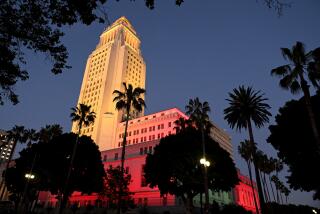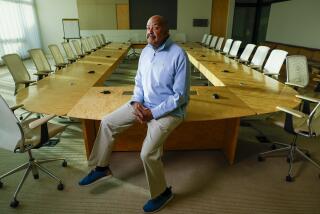Central City East Needs Help : Skid Row’s Needs Can Be Tackled If Those of Business Are Too
- Share via
Few things are more crucial to improving the vitality of Los Angeles’ Skid Row than the outcome of the debate over raising the amount of money the city’s Community Redevelopment Agency can spend on what is known as the Central Business District Redevelopment Project.
Natural tensions exist between the area’s business establishments and those who provide services for the homeless, whose population has swelled in the past several years. Business and social-service agencies both want more land to meet their needs. The two have differed so much in the past that we’ve often lost sight of our most urgent need--more money and better planning to improve our deteriorated physical environment.
The CRA spending limit, imposed by the court after a lawsuit over how redevelopment funds should best be allocated, is a serious roadblock to making significant progress in the Central City East area. Raising the cap can become the means by which businesses and service providers can reach our goals.
Critics of the CRA argue that it has been overly focused on building downtown skyscrapers. They contend that CRA has ignored the needs of the city’s less fortunate and that the agency is blessed with a decision-making process that insulates it from true public accountability.
The initial mission of the CRA was to rebuild Los Angeles’ financial core and set the stage for the “livability” of the central business district. No one who has seen the progress downtown over the last decade can argue over whether great changes have occurred. The growth of downtown’s commercial core has exploded. With each passing day, it is becoming a more comfortable place to live and work.
The CRA has won many battles but the war rages on. Beneath downtown’s new, shimmering skyline rest difficult problems.
For example, no one forecast the rapidly escalating growth of downtown’s homeless population and the resulting demands on a dilapidated and aging housing stock and a fragile social-service network. As a result, thousands of homeless roam the streets with inadequate mental-health services, medical care and shelter.
While the downtown most people see every day continues to flourish and thrive, Central City East wallows in some of the worst conditions in the city. To its credit, the CRA has pumped in millions of dollars of central business district redevelopment funds, generated by the increase in tax revenue that is due largely to the jump in property values downtown. Those CRA funds have been used to provide counseling, medical services, emergency shelter and safe parks, while stabilizing the area’s housing stock.
This is not enough. We hope to convince public decision-makers that more permanent affordable housing and homeless services must be provided citywide. However, we recognize that Central City East will continue to be the focus of these efforts for some time to come. What homeless advocates, service providers and businesses must all concentrate on is creating opportunities for the unfortunate to stabilize their lives and move out of Skid Row. The recently homeless must be trained so that they have the tools to live productively again. The hard-core mentally ill and substance abusers must be appropriately cared for in medical facilities, rather than being abandoned to eke out an existence in sidewalk cardboard boxes. Further, we must take back control of our streets and sidewalks so that safety is guaranteed to those people who work in Central City East.
The city and the CRA must also make a commitment to quickly complete a specific plan for the Central City East area to balance the needs of the expanding toy, food and fish-processing industries, as well as those of the residential community. Finally, the CRA can play a key role in forging an economic development strategy to encourage more light industrial and commercial investment in the area, thus creating much-needed blue-collar jobs.
To make these long-term, tangible improvements, the city must take an even more active position. First and foremost, this will require lifting the court-imposed limit on CRA spending in the central business district. The resources needed to close the large and growing gap between the resurging downtown business core and blighted Central City East will soon run out. If they do, all chances to create a safe place to live and work in our area will be lost. In that case, the homeless, those providing them services and local businesses will all lose.
If the cap is lifted, Mayor Tom Bradley has already earmarked more than $2 billion of the additional funds for a major affordable housing and homeless-related services program. Bradley has also dedicated up to $200 million to fund a school district-wide after-school education and child-care program for the next 20 years. This can be accomplished without adding another new skyscraper to the drawing boards.
Finally, a new spirit of partnership and cooperation must be developed between the CRA and the Los Angeles City Council. The result of this debate, we hope, will be a reinvigorated, fully funded effort by the CRA, backed by the City Council, that is ready to confront an urgent agenda of the unfinished business in downtown Los Angeles.
More to Read
Sign up for Essential California
The most important California stories and recommendations in your inbox every morning.
You may occasionally receive promotional content from the Los Angeles Times.










